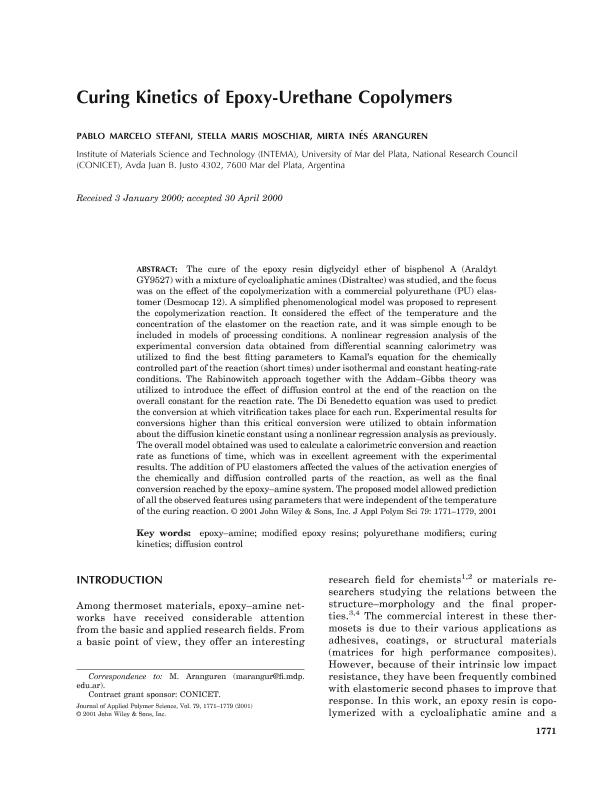Mostrar el registro sencillo del ítem
dc.contributor.author
Stefani, Pablo Marcelo

dc.contributor.author
Moschiar, Stella Maris

dc.contributor.author
Aranguren, Mirta Ines

dc.date.available
2018-02-19T21:48:27Z
dc.date.issued
2001-03
dc.identifier.citation
Stefani, Pablo Marcelo; Moschiar, Stella Maris; Aranguren, Mirta Ines; Curing kinetics of epoxy-urethane copolymers; John Wiley & Sons Inc; Journal of Applied Polymer Science; 79; 10; 3-2001; 1771-1779
dc.identifier.issn
0021-8995
dc.identifier.uri
http://hdl.handle.net/11336/36800
dc.description.abstract
The cure of the epoxy resin diglycidyl ether of bisphenol A (Araldyt GY9527) with a mixture of cycloaliphatic amines (Distraltec) was studied, and the focus was on the effect of the copolymerization with a commercial polyurethane (PU) elastomer (Desmocap 12). A simplified phenomenological model was proposed to represent the copolymerization reaction. It considered the effect of the temperature and the concentration of the elastomer on the reaction rate, and it was simple enough to be included in models of processing conditions. A nonlinear regression analysis of the experimental conversion data obtained from differential scanning calorimetry was utilized to find the best fitting parameters to Kamal's equation for the chemically controlled part of the reaction (short times) under isothermal and constant heating-rate conditions. The Rabinowitch approach together with the Addam–Gibbs theory was utilized to introduce the effect of diffusion control at the end of the reaction on the overall constant for the reaction rate. The Di Benedetto equation was used to predict the conversion at which vitrification takes place for each run. Experimental results for conversions higher than this critical conversion were utilized to obtain information about the diffusion kinetic constant using a nonlinear regression analysis as previously. The overall model obtained was used to calculate a calorimetric conversion and reaction rate as functions of time, which was in excellent agreement with the experimental results. The addition of PU elastomers affected the values of the activation energies of the chemically and diffusion controlled parts of the reaction, as well as the final conversion reached by the epoxy–amine system. The proposed model allowed prediction of all the observed features using parameters that were independent of the temperature of the curing reaction.
dc.format
application/pdf
dc.language.iso
eng
dc.publisher
John Wiley & Sons Inc

dc.rights
info:eu-repo/semantics/openAccess
dc.rights.uri
https://creativecommons.org/licenses/by-nc-sa/2.5/ar/
dc.subject
Epoxy-Amine
dc.subject
Polyuirethane Modifiers
dc.subject
Curing Kinetic
dc.subject
Difussion Control
dc.title
Curing kinetics of epoxy-urethane copolymers
dc.type
info:eu-repo/semantics/article
dc.type
info:ar-repo/semantics/artículo
dc.type
info:eu-repo/semantics/publishedVersion
dc.date.updated
2018-02-19T16:55:59Z
dc.journal.volume
79
dc.journal.number
10
dc.journal.pagination
1771-1779
dc.journal.pais
Estados Unidos

dc.journal.ciudad
ny
dc.description.fil
Fil: Stefani, Pablo Marcelo. Consejo Nacional de Investigaciones Científicas y Técnicas. Centro Científico Tecnológico Conicet - Mar del Plata. Instituto de Investigaciones en Ciencia y Tecnología de Materiales. Universidad Nacional de Mar del Plata. Facultad de Ingeniería. Instituto de Investigaciones en Ciencia y Tecnología de Materiales; Argentina
dc.description.fil
Fil: Moschiar, Stella Maris. Consejo Nacional de Investigaciones Científicas y Técnicas. Centro Científico Tecnológico Conicet - Mar del Plata. Instituto de Investigaciones en Ciencia y Tecnología de Materiales. Universidad Nacional de Mar del Plata. Facultad de Ingeniería. Instituto de Investigaciones en Ciencia y Tecnología de Materiales; Argentina
dc.description.fil
Fil: Aranguren, Mirta Ines. Consejo Nacional de Investigaciones Científicas y Técnicas. Centro Científico Tecnológico Conicet - Mar del Plata. Instituto de Investigaciones en Ciencia y Tecnología de Materiales. Universidad Nacional de Mar del Plata. Facultad de Ingeniería. Instituto de Investigaciones en Ciencia y Tecnología de Materiales; Argentina
dc.journal.title
Journal of Applied Polymer Science

dc.relation.alternativeid
info:eu-repo/semantics/altIdentifier/url/http://onlinelibrary.wiley.com/doi/10.1002/1097-4628(20010307)79:10%3C1771::AID-APP50%3E3.0.CO;2-D/abstract
dc.relation.alternativeid
info:eu-repo/semantics/altIdentifier/doi/http://dx.doi.org/10.1002/1097-4628(20010307)79:10<1771::AID-APP50>3.0.CO;2-D
Archivos asociados
